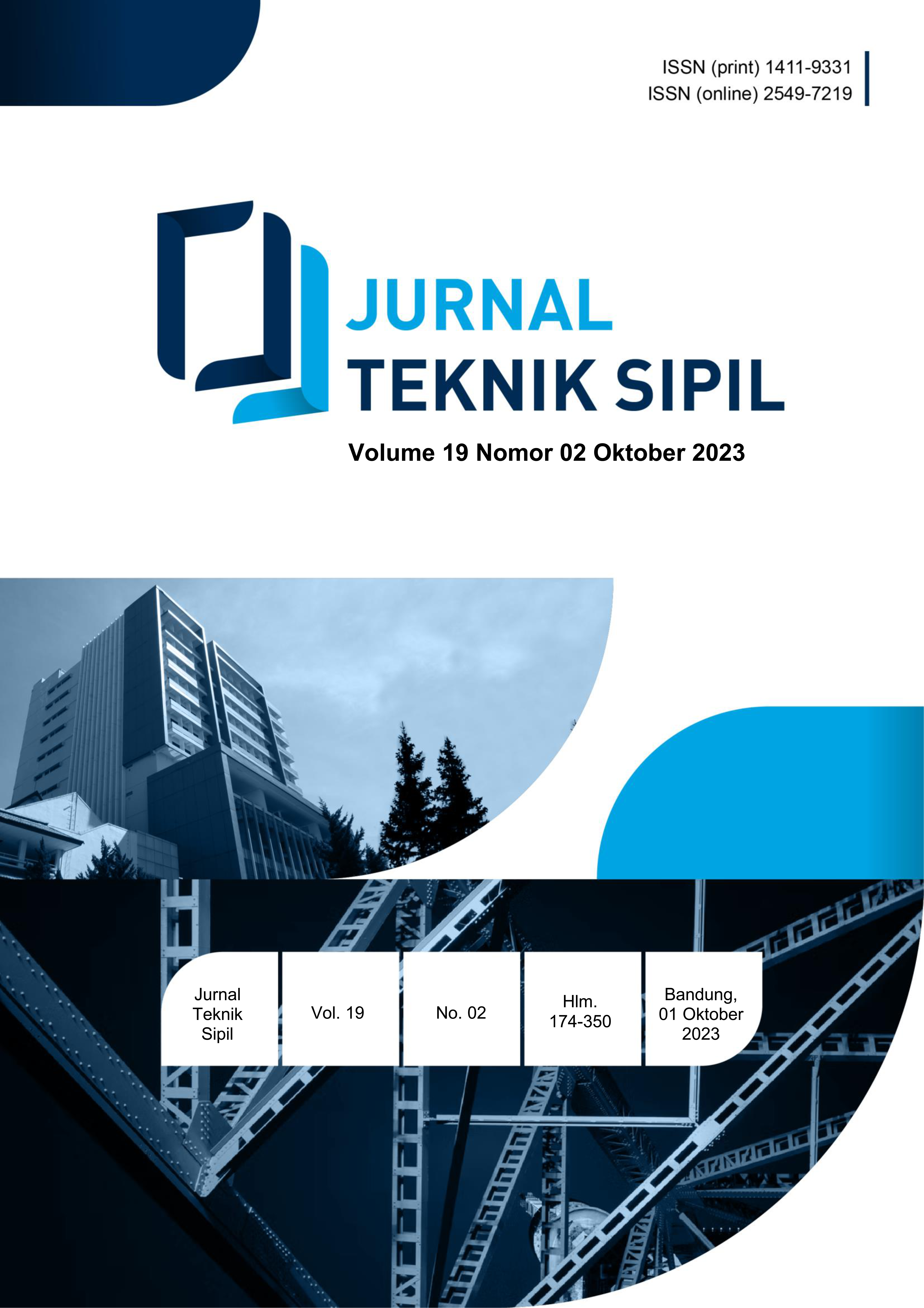Flexural Strength Ratio of Geopolymer Concrete with Addition of Superplasticizer
DOI:
https://doi.org/10.28932/jts.v19i2.6205Keywords:
compressive strength, flexural strength, geopolymer concrete, superplasticizerAbstract
Cement concrete is an alternative material in construction because it has high strength. Cement concrete has ingredients such as coarse aggregate, fine aggregate, cement and water. In produce cement have emissions such as dust particles, SO2, CO2, and other pollutants. Emissions can damage the environment so that alternatives are needed to solve them. Geopolymer concrete is concrete without cement. In this research, cement material was replaced by fly ash. This concrete is one of the environmentally friendly products because in its manufacture not using cement. In several research, the flexural strength value of geopolymer concrete has lower results compared to cement concrete. This research aims to increase the flexural strength value of geopolymer concrete so that equivalent cement concrete according to SNI 2847:2013 of 0,62√(fc'), with the addition of a 2% superplasticizer to increase the density of concrete. The beam test specimens used a size of 15 × 15 × 53 cm in total of 32 sample with mix design of geopolymer concrete using different molarities NaOH. Compressive testing and flexural testing according to SNI 1974:2011 and SNI 4431:2011. The result of this research is the flexural strength ratio of geopolymer concrete with the addition of 2% superplasticizer is 0,62√(fc'). The flexural strength ratio of geopolymer concrete equivalent to the flexural strength ratio of cement concrete in SNI 2847:2013 is 0,62√(fc').Downloads
References
Achmad, D., & Hidjan. (2012). Efek Perawatan Terhadap Karakteristik Beton Geopolymer. Jurusan Teknik Sipil, Politeknik Negeri Jakarta, 11(1), 79–86.
Badan Standar Nasional Indonesia, 2011. (2011). SNI 4431-2011 Cara Uji Kuat Lentur Beton Normal Dengan Dua Titik Pembebanan. 1–16.
Badan Standar Nasional Indonesia, 2013. (2013). SNI 2847-2013 Persyaratan Beton Struktural untuk Bangunan Gedung. 1–265.
Badan Standardisasi Nasional, 2011. (2011). SNI 1974-2011 Cara Uji Kuat Tekan Beton Dengan Benda Uji Silinder. 1–20.
Eunike, F., Paat, S., Wallah, S. E., & Windah, R. S. (2014). Kuat Tarik Lentur Beton Geopolymer Berbasis Abu Terbang (Fly Ash). Jurnal Sipil Statik, 2(7), 337–343.
Ginting, A. (2019). Perbandingan Peningkatan Kuat Tekan dengan Kuat Lentur pada Berbagai Umur Beton. Jurnal Teknik Sipil, 7(2), 110–125. https://doi.org/10.28932/jts.v7i2.1345
Hamidi, F., Aslani, F., & Valizadeh, A. (2020). Compressive and tensile strength fracture models for heavyweight geopolymer concrete. Engineering Fracture Mechanics, 231(January), 1–19. https://doi.org/10.1016/j.engfracmech.2020.107023
Herwani, H., Imran, I., Pane, I., Zulkifli, E., & Elvira, E. (2019). Efektivitas Superplasticizer Terhadap Workabilitas Dan Kuat Tekan Beton Geopolimer. Portal: Jurnal Teknik Sipil, 10(2), 12–18. https://doi.org/10.30811/portal.v10i2.975
Memon, F. A., Nuruddin, M. F., Demie, S., & Shafiq, N. (2012). Effect of superplasticizer and extra water on workability and compressive strength of self-compacting geopolymer concrete. Research Journal of Applied Sciences, Engineering and Technology, 4(5), 407–414.
Rajamane, N. P., Jeyalaskhmi, N., & Nataraja, M. C. (2014). Quantities of Sodium Hydroxide Solids and Water to Prepare Sodium Hydroxide Solution of Given Molarity for Geopolymer Concrete Mixes. ICI Technical Paper, 1–6.
Rumajar, R. J., Sumajouw, M. D. J., & Pandaleke, R. (2019). Kuat Tarik Lentur Beton Geopolymer Dengan Temperatur Ruangan. Jurnal Sipil Statik, 7(1), 67–72.
Santosa, B. (2019). Pemanfaatan Abu Serabut Kelapa (ASK) Sebagai Pengganti Sebagian Semen dengan Bahan Tambah Sikament-LN untuk Meningkatkan Kuat Tekan Beton. Jurnal Teknik Sipil, 5(1), 22–39. https://doi.org/10.28932/jts.v5i1.1310
Shehab, H. K., Eisa, A. S., & Wahba, A. M. (2016). Mechanical properties of fly ash based geopolymer concrete with full and partial cement replacement. Construction and Building Materials, 126, 560–565. https://doi.org/10.1016/J.CONBUILDMAT.2016.09.059
Sunarsih, E. S. (2017). Tinjauan Penambahan Aditif Mineral Abu Terbang Terhadap Ketahanan Beton Pada Lingkungan Agresi Sulfat. Indonesian Journal Of Civil Engineering Education, 1(2), 1–12. https://doi.org/10.20961/ijcee.v1i2.19986
Yamali, F. R. (2003). Pengaruh Bahan Tambah Kimia Terhadap Mutu Kuat Lentur Beton. Jurnal Ilmiah Universitas Batanghari Jambi, 11(3), 1–10.
Downloads
Published
How to Cite
Issue
Section
License
Copyright (c) 2023 Ester Surya Lie, Rachmansyah Rachmansyah

This work is licensed under a Creative Commons Attribution-NonCommercial 4.0 International License.















